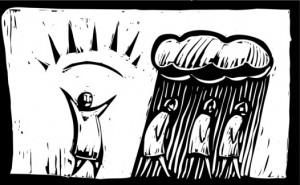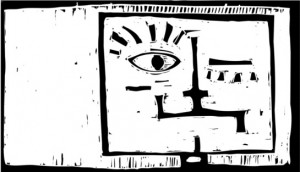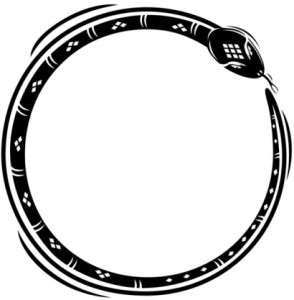Reconditioning the Bipolar (Part 1)
By Asher Crispe: March 11, 2011: Category Inspirations, Quilt of Translations
 Can we be serious and relaxed at the same time? Can the heart cry and be happy simultaneously? Can optimism and self-criticism co-exist? Psycho-spiritual health often requires a capacity to embrace the oppositional tendencies that characterize so much of our inner experience. To depolarize the self is an act of faith. In a kabbalistic context, faith is understood to be the power of the soul which transcends the limits of intellect and accepts super-rational paradox. Our cognitive abilities on the other hand operate on the basis of an exclusion principle which rejects opposites.
Can we be serious and relaxed at the same time? Can the heart cry and be happy simultaneously? Can optimism and self-criticism co-exist? Psycho-spiritual health often requires a capacity to embrace the oppositional tendencies that characterize so much of our inner experience. To depolarize the self is an act of faith. In a kabbalistic context, faith is understood to be the power of the soul which transcends the limits of intellect and accepts super-rational paradox. Our cognitive abilities on the other hand operate on the basis of an exclusion principle which rejects opposites.
Classic logic, in particular, likes either/or binary solutions. Life is either great or awful. The middle ground seems to be eroded by the mind. We can only intellectually experience one state at a time. By contrast, for the mystic, faith refers not to the binary bit, the one or zero, the something or nothing of computation, but to what has become known as the quantum “qubit”. In its normal use, a qubit represents an entanglement of many states at the scale sub-atomic particles such that they are in superposition one with the next. It is like saying something is both on and off at the same time. We can appropriate this concept and translate it into the psychological realm.
The tides of life are the modulations of a single sea. Our inner world cannot always be parsed out into either/or extremes. Subtle perception of co-extensive psychological states believes them to be clustered together. The “up” is never very far from the “down” and vice versa. By replacing either/or with both/and, we learn to hold together two contradictory states of being which cannot be entertained simultaneously within the straits of logic. Thus begins an essential rectification of the psyche and takes us along the path towards a healthy spiritual balance.
To tease this out a bit further, we find that when we speak about ourselves we often fall into the trap of saying ‘I am either this or that.’ ‘I am a good person’—by which we might be tempted to think that is all I am. ‘I am happy’ is occasionally registered as ‘I am only happy’. Or alternatively, ‘I am a bad person’ unearths that possibility that I am only a bad person. So too, ‘I am depressed’ can easily be confused with ‘I will always be for all eternity depressed’. A euphoric declaration that ‘everything is awesome’ whitewashes all traces of anything less than awesome temporarily. The same holds for ‘everything is miserable’.
This is a tendency of the mind to generalize and to exclude anything that does not fit with the picture. If things are good then it follows that they are not bad. Emotions born out of these thoughts are also binary in nature. We can only feel one thing at time. If things are good, then we simply feel good. No emotional multitasking is permitted. In the common way of reflecting about our life we are prone to forgetting in those good moments the existence of anything else, let alone moods that directly go against the grain of this dominate feeling. A person might even ask: was there ever a time when anything was not good? Everything is monochromatic. The same holds for the other pole. When one’s world seems to be falling apart then everything takes on the semblance of doom and gloom. In an unhealthy situation, polarized consciousness is pulled apart by the repulsion of the two poles.
 In truth, we are always in multiple states at the same time. We contain all sorts of oppositional tendencies. Our confounded being can sometimes be illustrated only with humor. There is a Monty Python Flying Circus sketch between a group of writers that captures the gist of our discussion as follows:
In truth, we are always in multiple states at the same time. We contain all sorts of oppositional tendencies. Our confounded being can sometimes be illustrated only with humor. There is a Monty Python Flying Circus sketch between a group of writers that captures the gist of our discussion as follows:
Larry: Get back in those seats immediately. Right you. The one in the middle, what do you think?
Second writer: (panic) Er…er…
Larry: Come on!
Second Writer: Splunge.
Larry: Did he say splunge?
First and Third Writers: Yes.
Larry what does splunge mean?
Second Writer: It means…it’s a great-idea-but-possibly-not-and-I’m-not-being-indecisive!
Larry: Good. Right…(to third writer) What do you think?
Third Writer: Er. Splunge?
Larry: OK…
First Writer: Yeah. Splunge for me too.
Larry: So all three of you think splunge, huh?
Writers: Yes!
Larry: Well now we’re getting somewhere.
Broadly speaking, many of the real world problems that we face, be they spiritual or physical, psychological or material, stem from some form of imbalance. One of the most important teachings in the Zohar (the classic text of Kabbalah) is the secret of the matk’la or balanced scale (literary of [equal] weight). For every measure there is a counter measure. Counter balancing forces help to stabilize a person and create equilibrium. The same holds true for an a imbalance of substances or an imbalance of energy. Why is health tied to balance?
This plays into another fundamental concept in Kabbalah called is ratzo v’shuv or ‘run and return’. The whole Torah is addressing this bi-polar tendency and is equal to the challenge of treating it. The kabbalists even emphasize this with a gematria (numerical allusion): Torah (תורה) equals 611 as does the Hebrew expression ‘run and return’ (רצוא ושוב).
What is so special about this expression that it is equivalent to the entire Torah? We might respond by asserting that the whole of the Torah is in a certain sense addressing a primal bipolarity that underlies the human condition as well as the whole of existence. In short: the run is the advance and ascent while the return is retreat and withdrawal. The run denotes a person’s strong desire to improve, to go beyond, to transcend. By contrast, the return represents a falling back. With all of our striving to be better we sometimes yearn to run up to and approach perfection only to realize that it is unattainable.
Frustrated by having to come back down from our climb we might succumb to anxiety over failure. Many have crashed after having temporarily achieved an elevated status. Upon discovering that we cannot always live at high altitude can cause us to take a dive. Life is defined by these highs and lows. The issue is when the higher the high brings a lower low that proves to be too radical a swing between extremes.
If a person has the capacity for inner psychological balance, then everything is in order. Such a person can handle the highs and lows fairly well. We are well conditioned to accept that life is bumpy. We are excited to surf the waves of our experience rather than let them toss us about and drown us. In Chassidic philosophy this is depicted as a tacit acceptance of a descent for the sake of an ascent or even an ascent for the sake of a descent. The problems really begin when a person lacks this initial balance. Remaining upright amidst the ups and downs comes from a finely calibrated internal gyroscope.
In the absence of balance, preserving and maintaing equilibrium, even on the short term, has its challenges. How well can we handle the psychological fluctuations that are par for the course in day to day living let alone in cases where we are taken to the extreme? The goal is mental stability—but this requires a certain comfort level with upheaval. Do the disturbances really disturb me or can I remain somewhat relaxed and go along for the ride. How good are our shock absorbers?
 From the perspective of the Torah, the more balanced a person, the more that person can be permitted to climb higher. If we want to break out we have be balanced about it. Consequently, if we are unbalanced then we have to remain self-contained. As far as Torah archetypes, the figure who best represents this balanced approach is Jacob (Yaakov). About Jacob, it is specifically stated that he would expand spiritually beyond boundaries: “you will breakout to the west, to the east, to the north and to the south” (Genesis 28:14).
From the perspective of the Torah, the more balanced a person, the more that person can be permitted to climb higher. If we want to break out we have be balanced about it. Consequently, if we are unbalanced then we have to remain self-contained. As far as Torah archetypes, the figure who best represents this balanced approach is Jacob (Yaakov). About Jacob, it is specifically stated that he would expand spiritually beyond boundaries: “you will breakout to the west, to the east, to the north and to the south” (Genesis 28:14).
Coming back to the expression “run and return”, it should be pointed out that this expression appears only one time in the Hebraic Bible, in the book of Ezekiel (Yechezkel 1:14) with reference to what is known as the vision of Divine chariot. There it describes how “the living creatures run and return like the appearance of lightning.” According to the commentary tradition (Rashi), they ascend to be before the face of the Divine presence but this light is so great and overwhelming that they recoil backwards and return to their places. Moreover, the term for these living creatures (hachayut) also means vitality. The implication is that the basic pulsation of life may be compared to this the movement of run and return. Just think of a heart beat displayed on a EKG. There we certainly appreciate the importance of the ups and downs. Emotionally accepting that balance does not imply flatlining turns the highs and lows into opportunity and vital energy.
Along a similar line of explanation, the run of the soul marks the movement of desire for the infinite—to lose oneself, to go out of one’s body, to go out of one’s mind, to go out of one’s vessels. Here a person is lacking containment. My containment field is broken. The vessel bursts. How many time have we said ‘I couldn’t contain myself.’ Taken to the outer limits, this may even produce an affect of feeling expired—the soul exiting from the body.
As a counterweight and safety mechanism, the soul will, under proper conditions, recoil from sudden and spontaneous lift, retreating and falling back out of fear. Natural anxiety over the potential loss of one’s life tempers our desire for the unbridled rush to the heights. We don’t want to get too carried away in the process. At a certain point, our healthy sense of danger in proceeding any further should kick in and turn us back. Climbing any higher presents a significant risk. Even if we can come back down, we might remain damaged by the experience. Proceed with caution.
Sometimes the run up is expressed as the movement of attraction and love, while the retreat and recoil is the movement of repulsion and fear. This motion of ascending and descending, highs and lows, can psychologically pull a person apart and lead to a spilt personality or schizoid tendencies. For a person who is defined as “normal” these motions occur at different times—first one mood then its opposite. Oscillation between joy and depression, excitement and boredom, washes over us at various frequencies and intensities. Moods that are separated in time may aid in our dis-owning some of them. In other words, being locked into our emotional present repaints our past and future (if not the world at large) with the hue of that current feeling.
In Psalms 107:26 we encounter the verse “They rise to the heavens, and they descend to the depths….” While this entire chapter of Psalms describes a struggle with the bipolar nature of existence, this particular verse details the crux of one who is taken to extremes. As a psychological condition, wherein the person could be likened to a ship sailing into the heart of a stormy sea, this tumultuous feeling defines a chaotic state of being. The more we go to heaven (ascend euphorically), the more we subsequently descend down to the abyss. Plunging into the abyss, falling further and further with no bottom in sight, may be encountered as depression. In Chassidic thought, there is the expression: the abyss of the self. Mired in self, thrown into the bottomless pit of broken ego, brings forth depression.
But what about a person who undergoes these extremes of inner experience while remaining balanced? In Chassidic philosophy, there exists a notion of two distinct types of chaos. The first is ‘bounded’ chaos (ekudim) where the bumps or waves are countered with an inward sense of balance. We might even borrow a science term and dub this as a state of stable chaos. As for the second variety, no such stabilizing factor assists us. We are talking total chaos. Everything has gone to pieces in a world fragmented into unrelated ‘points’ (nikudim). Obviously, we want to navigate the extremes in a manner that allows us to pull ourselves together rather than being ripped apart.
The key to obtaining stable chaos is to always have in mind the opposite of which ever extreme experience one is undergoing. For example, we need to be reminded that there is still work to do and room for improvement especially when we feel like everything is perfect. Likewise, when we appear to have fallen, we have to refocus our attention on the unnoticed good that is hiding out all around us, to greet each new instant of life as a potential redemption for the pervious one.
In particular, Jewish custom pays careful attention to depolarizing our extreme highs and lows. It is specifically, when we should be at an all time high of joy at one’s wedding, that Jewish tradition insists that we break something. Usually this is a glass which is stomped on under the chupah (bridle canopy). This is to remember the destruction of the Temple (Beit Hamikdash) in Jerusalem. What does this accomplish? It wakes us up to the idea that parts of reality are still broken. All is not yet right in the world. So even while we rejoice, we must trigger a consciousness of the other extreme of emotion.
 Finally, there is another mirrored expression of this idea on the ninth day of the Hebrew month of Av. In the Jewish calendar there is no sadder day than this. We commemorate the destruction of both the first and second Temples of ancient Israel as well as a host of other terrible tragedies throughout Jewish history with a full day of fasting. Yet at this darkest and lowest point in the psychological year, we are informed by the sages of the Talmud that this day is also the birthday of the Moshiach (Messiah) in as much as the potential for the redemption of the world and the building of a third and final Temple would only be possible after the destruction of the first two. This is to say that it is specifically during to biggest low that we have to reflect upon the greatest high as represented by the messianic era.
Finally, there is another mirrored expression of this idea on the ninth day of the Hebrew month of Av. In the Jewish calendar there is no sadder day than this. We commemorate the destruction of both the first and second Temples of ancient Israel as well as a host of other terrible tragedies throughout Jewish history with a full day of fasting. Yet at this darkest and lowest point in the psychological year, we are informed by the sages of the Talmud that this day is also the birthday of the Moshiach (Messiah) in as much as the potential for the redemption of the world and the building of a third and final Temple would only be possible after the destruction of the first two. This is to say that it is specifically during to biggest low that we have to reflect upon the greatest high as represented by the messianic era.
In this fashion we may begin to embrace the extremes and preserve our psychological balance at the same time. Ultimately, the high is en-wedged in the low and the low in the high.
Reconditioning the Bipolar (Part 1),















;)
;)
;)
;)
;)
;)
;)
;)
;)
;)

What is vrudim in this scheme?
Wow thank you for this writing. I’m absorbing it through the senses and am seeing circles, loops, black holes, donuts. The colors black to white and everything in between. The feeling and sound is one of pulsing, crashing – which paradoxically is sometimes silent – and then humming harmony going towards silence. Plants too seem to come from a dark place and open up to the light then return to the dark place, sometimes falling to be absorbed by the earth and sometimes folding inwards to their center and I think the only reason they stay healthy is because can move away from and return to their dark interiors in complete balance.
I’m reading this after hearing of the passing of my mother-in-law, may she rest in peace. She was buried on a beautiful hillside in Jerusalem as the late-day sun and a soft breeze tempered the summer heat. The grief and the relief. She was in a coma for several years so there is grief and there is great relief that her soul is free. That my father-in-law can grieve instead of visiting a body in the hospital every day all these years. This is more challenging for my son, who is the embodiment of dichotomy. Suffering with severe bipolar disorder, he soars so high, understands so much, and he can be haunted by demons no one should ever know. I’m praying he finds the balance you speak about. I see that as a goal, but I know that it is a challenging state to achieve. What a wonderfully insightful, meaningful, and yes, comprehensible article. Much appreciated at this time, at any time. Thank you.
Thank you so much for your comment!